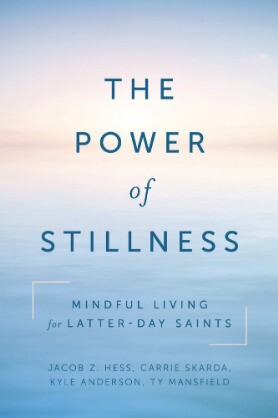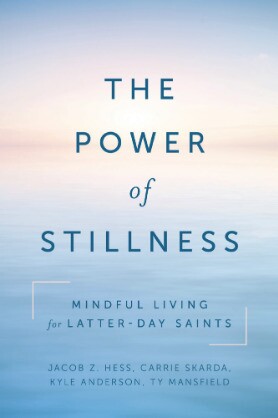Elder Richard G. Scott once shared: “Many voices from the world in which we live tell us we should live at a frantic pace. There is always more to do and more to accomplish. Yet deep inside each of us is a need to have a place of refuge where peace and serenity prevail, a place where we can reset, regroup, and reenergize to prepare for future pressures.”
Rather than prioritizing refuge, our tendency is often the reverse. Sister Sharon Eubank has acknowledged, “I am a maximizer, so I tend to think if one is good, five is better, and ten is best, and then I am completely overwhelmed.” And Sister Reyna Aburto has also spoken of creating long lists for herself on the weekends that never seemed to relieve the pressure, saying, “I felt that I was never done.”
We have often heard the private cries of people for whom a sense of never being able to do or be enough has left them feeling hurt and alienated from God. And yet, in some cases, well-intentioned leaders have advised overwhelmed people that the solution is to “do” more. As a local leader asked in one of our wards, “What is your temple attendance? Double it. How much time do you spend visiting? We’ve got to double it.”
Sometimes more effort is needed, of course. But other times more doing might step beyond the “wisdom and order” of the gospel (Mosiah 4:27)—leaving people depleted and spiritually vulnerable.
Flattening Worship
A young Latter-day Saint mother recounted: “[I was] going going going, serving as Primary president, doing everything, involved in everything, volunteering for everything, and feeling. So. Tired. My thought processes were along the lines of ‘I must not be praying enough. Or serving enough. Or reading my scriptures long enough.’”
After she had pushed herself to the point of contracting mononucleosis, her husband one day said, “This is not what Heavenly Father expects of you!”
Author Wendy Ulrich notes, “God doesn’t burn out or use up one person to ‘save’ another, that’s just not God’s economy.” Pastor Christopher Ash argues that when we serve or take on more than God has actually assigned us, without acknowledging our limits and need for rest, we are demonstrating a distrust in God’s ability to “handle it” without our “help.” He calls rest “an exercise in trust,” adding, “God has already appointed his Messiah, and he did not appoint you.”
Although all believers know such divine help exists, our customary language often directs attention largely to our own actions. For example, instead of communing with God, we speak of “getting a chapter done,” “saying a prayer,” or “doing a session.” In what ways might this kind of language inadvertently change what we’re actually hoping to experience?
Too Busy to Receive Anything New
A story is told about a Zen master meeting his eager student for the first time. As they sit to talk, the master starts pouring tea until the cups are full. But he keeps pouring. As the student watches the tea pour all over the table and onto the floor, he finally asks, “Why do you keep pouring when the cup is already full?” The master responds, “That overfull cup is like your overfull mind. There is no room for me to add anything. You have to empty your mind if you want to take in anything I have to offer you.”
Do you know what it’s like to have an “overfull mind”—to the point that there’s simply no room for anything more? Citing the limited handcart space that forced earlier Latter-day Saints to leave some things behind, Elder Jeffrey R. Holland reflected that we may also need to ask what can truly fit in our own finite “handcart” space, and what needs to be tossed off. He suggested that “maybe a lot of other less needed things [can] sort of fall out of the wagon.”
In one translation of Paul’s letter to the Philippian Saints, he states that Jesus “emptied himself ” so that He could do the work of the Father (Philippians 2:7, New English Translation). In our own communion with God, it may require a similar emptying of ourselves—our minds, our stories, our expectations of what “should” be happening—in order for us to be taught and tutored by Him. Admittedly, as seen in the story of Mary and Martha (seeLuke 10:38–42), sometimes it can be really good things (how about serving dinner to the Lord Himself?) that lead us to be so “cumbered about much serving” that we’re hardly able to sit at His feet and relish His words anymore.
The Restoration Mindfulness Advantage
And this is where the Church of Jesus Christ deserves a little (or a lot) more credit. In our attention to the many needful things to do as members of Christ’s Church, sometimes the many excuses Saints have to stop doing are overlooked. Compared to a typical modern schedule, think of all the opportunities we have to stop: the Sabbath, personal prayer and scripture study, family meals, family prayer and scriptures, date night, family home evening, sacrament, the temple, and more.
Wow! Every one of these events is a prime “stopping time”—especially if we approach it in that way. Rather than a divinely prompted pause in our stream of doing-many-other-things, however, these sacred practices often still remain just-one-more-thing-to-do.
What would happen to us emotionally and spiritually if we approached these spiritual practices (each of them) as intentional moments of respite and sanctuary?
Instead of “all these things to do,” imagine approaching each of these sacred practices “on purpose, in the present moment, nonjudgmentally, as if our lives depend on them.” In this way, we can come to experience:
• What it feels like to kneel before God not simply to say more words—but also, to rest in His presence in stillness and silence.
• What it’s like to sit down as a family not simply to “get a chapter done”—but instead, to hold scriptural text as an anchor to focus minds and hearts and facilitate an ongoing exploration about
God’s hand in our lives.
• What it’s like to go to the temple not to “do a session”—but instead to stop doing—and to enjoy being in the haven of God’s home, pondering His creative work in the world and in our lives.
None of these possibilities, of course, are foreign. References to a spacious, heart-full approach to gospel living are laced throughout scriptural and general conference teaching. But that doesn’t make it easy to practice! As President Gordon B. Hinckley said:
We live in a very mad world when all is said and done. The pressures are tremendous. We fly at high speeds. We drive at high speeds. We program ourselves. . . . But there is hardly time to reflect and think and pause and meditate. I daresay that most of those in this room today have not taken an hour in the last year to just sit down quietly, each [one individually] . . . reflecting upon his place in this world, upon his destiny, upon his capacity to do good, upon his mission to make some changes for good. We need to. I recall so vividly President McKay in his old age in a meeting with his counselors and the Twelve saying, “Brethren, we do not spend enough time meditating.” “I believe that with all my heart,” President Hinckley added, while also acknowledging, “Your needs and your tastes along these lines will vary with your age. But all of us need some of it.”
Do you have some of it? The good news is that mindfulness is absolutely everywhere within the restored gospel, as long as we are willing to recognize it.
Latter-day Saint Mindfulness Lingo
One reason that the mindfulness of Latter-day Saint living sometimes remains hidden is that we have a different language to describe how to cultivate stillness. For instance, the Latter-day Saint version of “practice mindfulness regularly” sounds more like “read the scriptures and pray daily.” Our version of “it’s really valuable to prioritize regular retreat” is instead, “be in the temple often.” “Pondering” is also typically used instead of “meditation,” and “reverence” instead of references to silence or stillness. Once we begin to translate into familiar terms, the powerful parallels become evident. Listen, for instance, to President David O. McKay’s teaching here with that lens:
The greatest manifestation of spirituality is reverence; indeed, reverence is spirituality. Reverence is profound respect mingled with love. . . . Reverence directs thought toward God. Without it there is no religion.
Gospel Living as Ongoing Contemplative Practice
Rather than incessant excuses to “keep going” and “keep doing,” then, so much of Latter-day Saint faith practice can be legitimately experienced as ever-ready excuses to stop meaningless busyness, and instead to sit with loved ones, sit with neighbors, and especially to sit at the feet of our Lord and His Father . . . whether or not dinner gets done on time!
Rather than something to “finish,” prayer can thus become a sacred practice of personal retreat. Instead of something to “get through,” scripture study can be a divine communion assisted by His words. And the Sabbath itself can become a relished mindfulness retreat happening each week, right within the walls of our own homes and chapels. In each case, these practices can become life-changing anchors in a larger culture swirling around us with hurricane force. As Elder Scott has also taught, “Without these regular practices it will be difficult to find the desired and much-needed peace and refuge from the world.”
In all these ways, rather than merely expanding activity or busyness, living the gospel can be experienced as a set of deeply restorative practices that help to cultivate more stillness in our lives—and all the divine inspiration and intimacy that can arise from just a bit more calm and space.
Lead image from Shutterstock
Learn about other ways you can bring more peace into every part of your life by reading the brand-new book Power of Stillness: Mindful Living for Latter-day Saints by Jacob Z. Hess, Carrie L. Skarda, Kyle D. Anderson, and Ty R. Mansfield, available at Deseret Book stores and on deseretbook.com.



